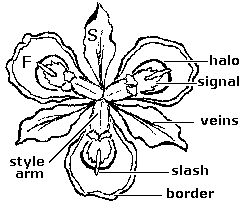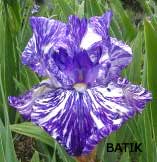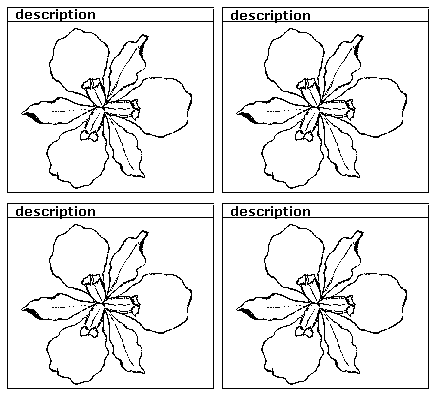Almanac Article
Do We Speak the Same Language?
Jean Witt, Des Moines, Washington
Illustrations by Jean Witt
Almanac, Fall 2003 Vol.32, No.1: 7-8
(Adapted and slightly modified for the web)
Are we all using similar terms when writing descriptions of our Pacific Coast Iris for the registrar? I checked into this recently, and the answer is, in general, yes. Could we improve our descriptions? Probably, and we may need to because it appears that our patterns are becoming increasingly complex.

While most recent descriptions are sufficiently detailed, excessively brief accounts (especially of older varieties) pose difficult problems. So what are the terms we use to describe the various features of our flower? Are there others that we could add?
Following are some of the results of my survey. To encourage consistent descriptions, here is a flower diagram showing some of the terms listed below.
[S=standards, F=falls]
Relatively plain flowers present are not difficult. SELF: S, F, and styles all the same solid color, no markings; darker or lighter styles are occasionally mentioned. BITONE: S and F with different values of the same color; may have paler styles. BICOLOR: S and F with different colors. PLICATA: lined or dotted borders; sanded.
Flowers with more elaborate patterns require additional terms.
BORDERS (solid color): edging, banding, rimmed (if fairly wide), or WIRE EDGE: fine pencil edge, hairline edge, 1/16 inch edge, if narrow. Such borders are usually white or light on dark flowers, but may be dark on white or pale flowers. The term haloed has occasionally been used in this context, but I suggest that halo is better applied to signals.
VEINING (the pattern found naturally in I. purdyi, I. innominata, and the hybrid VALLEY BANNER): also described as lines, heavily lined, patterned, radiating lines; almost always dark, but can be yellow on white or pale yellow ground. Obvious contrasting veining on standards should be mentioned. Do we have any LUMINATAS (white veins on colored ground)?
Words dealing with SIGNALS are extremely varied: eye, spot, blaze, thumbprint, central area, bleeding spot, watercolor signal (blurred edges), diffuse signal, divided signal, eye spots. Size is sometimes indicated (small, large, ½ inch, etc.). Modifications include centerline, slash, flash, and streak. Surrounding the signal we can have halos, horseshoes, or rings (usually a line or a band), but also sometimes frecked or strippled, whiskers, eyelashes, or rays. EXTRA COLOR is described as overlaid, stained, hazed, flushed, washed, blushed, infused. If extra color solidly covers most of the petal, is it still a signal? To me, signal is by definition, limited in area, so I think we need some other term for nearly complete coverage of the blade by one color over another.
Style arm color isn't usually given, except when it is darker or lighter than the S and F. Tinted style arm tips are worthy of comment. Extra color in the throat of the flower has been described in only a few cases; ditto for perianth tube color – perhaps flowers like my innominata-macrosiphon hybrid with its startling purple-black perianth tubes under biscuit colored flowers are not common. An occasional description mentions reddish leaf bases.

I found no instances of BROKEN COLOR (as in the border bearded iris BATIK), or any named examples of variegated foliage.
If you have found a distinctive new pattern, please let us know! Copy the blank outline below, fill in the colors with colored pencils, crayons, or paints, and send it to our ALMANAC editor. We are trying to find out just how many patterns we have. We suspect that PCIs have more variations than any other group of irises. Perhaps you may have some additional terms to suggest.
Here are some sample descriptions of a few of my new seedlings:
S medium red-violet, F with a yellow signal, ringed with a white halo outlined in violet; remainder of blade red-violet, paling to lavender at the edges.
S violet; F with a yellow central slash, surrounded by a violet-veined white signal area with an eighth-inch dot or dab of violet near the outer end; outer 2/3 of blade violet. (The next year this flower had two little purple dabs, like a Hitler mustache!)

Here are several descriptions of named varieties that impress me as illustrating the sort of detail we desire:
S pale buff yellow, F with a small deep orange-yellow signal, surrounded by a white area crossed by violet veins; outer portion of F pale buff yellow, unveined.
One of my I. macrosiphon clones has a median white slash on the blue falls that extends ½ inch beyond the signal area. Sometimes this sort of line extends clear to the tip of the petal.
S pastel russet red, rimmed lemon; F deep russet red, rimmed lemon; cadmium yellow signal lightly veined russet.
S orchid, F red-violet, lighter hairline edge, black signal.
Purple self, F with a large heart-shaped ivory flash.
Silvery lilac-blue, F with precise violet signal.
Cherry red, blushed gold, thin cream edge; F with gold signal withfine darker gold veining; style arms cherry, blushed gold.
And here are a couple that could have been more specific:
Peachy cream shaded brown yellow, with turquoise blush and dots.
White ground, washed blue, edged white.